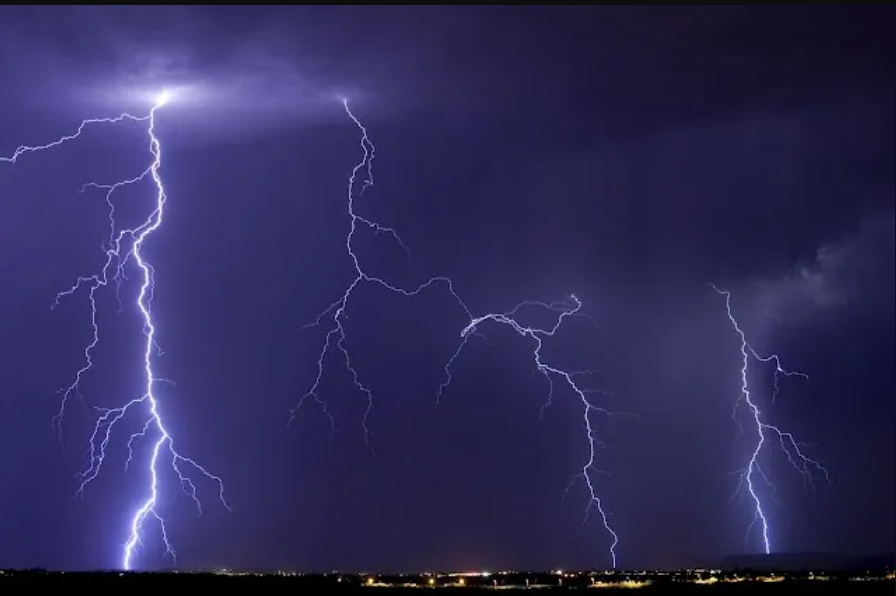Dark Lightning, a natural phenomenon that has long intrigued scientists, is a subject of ongoing research. This mysterious occurrence is not visible to the naked eye, unlike its more well-known counterpart, bright lightning. Dark lightning is a sudden discharge of gamma rays that takes place during thunderstorms. It is a fascinating subject because it is relatively unexplored and is believed to occur sporadically during standard lightning storms. The gamma ray flashes, which are a type of ionizing radiation, carry a million times more energy than the visible light spectrum.
The phenomenon was only discovered in recent decades, specifically in the early 1990s, with the launch of space-based observatories. These observatories were designed to detect cosmic gamma rays but ended up discovering this enigmatic terrestrial phenomenon. The flashes of dark lightning are brief, lasting only a few thousandths of a second, which makes them challenging to observe and study. They are also not accompanied by any audible sound, unlike typical lightning, which is often accompanied by a loud thunderclap.
While the exact mechanisms behind dark lightning are not entirely understood, scientists believe that it is a result of the strong electric fields within thunderstorms. As these electric fields become more intense, they can accelerate electrons to near the speed of light. When these high-energy electrons collide with air molecules, they produce a burst of gamma rays. This process, known as bremsstrahlung, is thought to be responsible for the generation of dark lightning.
However, the occurrence of dark lightning in our atmosphere raises substantial questions, particularly about its potential impact on the environment and human health. The high levels of ionizing radiation that dark lightning produces could potentially be harmful to living organisms. Scientists have raised concerns about the potential exposure of commercial airline passengers and crew to dark lightning, although the risk is believed to be minimal due to the infrequency of the phenomenon.
Nonetheless, research into dark lightning continues, with scientists seeking to better understand this intriguing phenomenon. The study of dark lightning not only holds the potential to advance our knowledge of atmospheric science but could also have implications for other fields such as astronomy, space weather, and radiation biology. Despite the challenges in observing and studying dark lightning, the allure of uncovering the mysteries of this elusive phenomenon continues to drive scientific inquiry.
In conclusion, dark lightning represents one of the many enigmas of our natural world, a testament to the boundless wonders and complexities of the universe. As we continue to probe and unravel its secrets, we may come to realize that dark lightning, like many other natural phenomena, offers us a glimpse into the intricate and interconnected workings of the cosmos. It reminds us that there is still so much to learn and discover about the world around us, and that each new discovery brings us one step closer to understanding the true nature of our universe.

What is Dark Lightning? Understanding the Basics
Dark Lightning, a relatively new term in the field of meteorology, is a fascinating and mysterious phenomenon that continues to baffle scientists. Essentially, it refers to a burst of gamma radiation that occurs within thunderstorms. Unlike the typical bright, visible lightning that we are all familiar with, dark lightning is almost invisible to the naked eye. The term ‘dark’ is therefore a fitting description, as it’s not dark in color, but rather in its lack of visibility.
First detected by satellites in the late 1990s, dark lightning is believed to be produced by the same atmospheric conditions that generate regular lightning. However, instead of releasing a flash of light and sound, dark lightning discharges a significant amount of high-energy radiation. These gamma rays, the most energetic form of light, are billions of times more energetic than the type of light visible to our eyes.
Understanding the basics of dark lightning is a complex task, as the phenomenon is still a subject of ongoing research. It is thought that the process begins with the movement of electrical charges within a thunderstorm. As the storm grows, it creates an electric field. When the field becomes strong enough, it can accelerate electrons to near the speed of light. These high-speed electrons then collide with air molecules, creating a chain reaction that results in the production of gamma rays.
While it’s a captivating topic, it also raises potential safety concerns. The radiation levels from dark lightning are extremely high, but the occurrence is so fleeting that it doesn’t pose a significant risk to humans on the ground. However, for air travelers, the exposure could be greater. Researchers are therefore studying dark lightning intensively, not only to understand its nature but also to determine the potential risks it may pose to air travel. As our knowledge about this mysterious phenomenon expands, we can hope to uncover the full story behind the intriguing spectacle of dark lightning.
Scientific Evidence and Research on Dark Lightning
Dark lightning, also known as terrestrial gamma-ray flashes (TGFs), is a relatively recent discovery in the field of atmospheric science that has garnered widespread research and attention. This phenomenon is essentially a burst of gamma rays that occur in Earth’s atmosphere during thunderstorms. The study of this atmospheric spectacle has been largely facilitated by space-based observatories, such as NASA’s Fermi Gamma-ray Space Telescope, which has been instrumental in detecting and analyzing these TGFs.
Scientific evidence suggests that dark lightning is a byproduct of the same processes that generate regular lightning. It is believed to occur when a build-up of electric energy in a thunderstorm creates an acceleration path for electrons. These electrons then collide with air molecules, creating a chain reaction that results in a flash of gamma rays. However, unlike regular lightning, dark lightning is invisible to the naked eye and does not produce any sound.
Despite being a relatively recent discovery, dark lightning has already had significant implications for our understanding of Earth’s atmospheric processes. For instance, research has suggested that TGFs may play a role in the natural balance of Earth’s radiation belts. Moreover, the gamma rays produced by dark lightning are of such high energy that they can pass through airplane walls, potentially exposing passengers and crew to radiation levels equivalent to hundreds of chest X-rays.
While much has already been learned about dark lightning, several questions remain unresolved, underlining the need for further research. For example, the exact mechanisms through which TGFs are generated, and the frequency of their occurrence, are still not fully understood. Similarly, the potential effects of dark lightning on human health and the environment are still largely unknown. As such, the study of dark lightning represents a rich and exciting frontier in atmospheric science, with the potential to enhance our understanding of Earth’s complex climatic and weather phenomena.

How Dark Lightning Differs from Traditional Lightning
Dark Lightning, also known as Terrestrial Gamma-ray Flashes (TGFs), is a phenomenon that distinctly differs from traditional lightning. Unlike conventional lightning that we are familiar with, dark lightning is not visible to the naked eye. It doesn’t create the brilliant flash of light or the thunderous sound associated with regular lightning. Instead, it emits high-energy gamma radiation. This type of lightning occurs in the Earth’s atmosphere during thunderstorms, just like traditional lightning. However, it is much less common and has only been observed with the help of specific scientific equipment.
One of the primary differences between dark and traditional lightning is the energy involved. Traditional lightning discharges a vast amount of electrical energy, heating the surrounding air, causing it to glow, and creating the flash we see. This process also causes the air to expand and contract rapidly, leading to the sound of thunder. On the other hand, dark lightning involves the transformation of electrical energy into gamma radiation and does not have the same visual or auditory effects.
Another crucial difference is the potential danger they pose. While traditional lightning can be deadly due to its high electrical charge and heat, dark lightning poses a different kind of threat. The high-energy gamma radiation it emits can be harmful if one were to be in close proximity. Fortunately, the odds of that happening are extremely low.
Dark lightning and traditional lightning also differ in their discovery and study. Traditional lightning has been observed and studied for centuries, while dark lightning was only discovered in recent decades with the advancement of technology. Despite these differences, both types of lightning contribute to the understanding of atmospheric physics, offering insights into electrical discharges, radiation, and the Earth’s electromagnetic field.
The Impact of Dark Lightning on the Environment and Technology
Dark lightning, a natural weather phenomenon that emits high-energy radiation, has substantial implications for both the environment and technology. Despite its name, dark lightning is not visible to the human eye, but its impact is undeniable. From an environmental perspective, dark lightning acts as a natural source of radiation, releasing bursts of gamma rays into the atmosphere. This radiation can influence atmospheric chemistry, particularly the concentration and distribution of greenhouse gases, which could potentially affect climate change patterns. However, the full extent of its environmental impact remains a subject of ongoing scientific investigation.
On the technological front, dark lightning poses a significant challenge to space-based technologies and aviation. This is primarily due to the high-energy gamma radiation it produces, which has the potential to damage electronic equipment. For instance, satellites in space can experience temporary disruptions or permanent damage when exposed to these powerful gamma rays. Similarly, aircraft flying through regions of dark lightning could risk electronic malfunction.
Moreover, since dark lightning radiation is far more penetrating than regular lightning, it represents a potential health risk for astronauts in space and air travelers. The exposure to high levels of radiation could increase the risk of developing harmful health conditions.
While our understanding of dark lightning is still evolving, it is clear that this atmospheric phenomenon has far-reaching effects. It underscores the need for further research to mitigate its potential hazards and adapt our technology to withstand its impacts. This would entail developing more robust space-based technologies and aircraft systems, as well as improved forecasting models to predict dark lightning events. In essence, dark lightning is a stark reminder of nature’s power and the importance of understanding its influence on our world.

Current Theories and Future Research Directions
The realm of current theories and future research directions is an ever-evolving landscape that thrives on constant inquiry, new discoveries, and innovative thinking. Across all disciplines, from physics to sociology, theories presently accepted offer a comprehensive understanding of various phenomena, guiding the trajectory of scholarly exploration. However, they are not static; they evolve, adapt, or are replaced as new evidence comes to light or fresh perspectives emerge. Theories such as quantum mechanics in physics, the Big Bang theory in cosmology, or the theory of evolution in biology have undergone modifications and refinements over time, indicating the dynamic nature of scientific knowledge.
As we move forward, the future of research is expected to be as exciting as it is uncertain. Emerging technologies like artificial intelligence, quantum computing, and advanced biotechnology are likely to redefine our understanding of many concepts, presenting new theoretical frameworks. Additionally, pressing global issues like climate change and pandemics necessitate urgent research, potentially giving rise to novel theories and paradigms.
Future research directions would be greatly influenced by interdisciplinary approaches, with the integration of diverse fields leading to more holistic and comprehensive theories. For instance, neuroeconomics, a burgeoning field that integrates neuroscience, economics, and psychology, has the potential to revolutionize our understanding of decision-making processes.
Notably, the ethical implications of research and theoretical developments will be of paramount importance in the future. As we delve into uncharted territories, ensuring that the pursuit of knowledge is compatible with societal norms and values will be a crucial consideration.
Lastly, the role of technology in democratizing access to research and fostering collaboration cannot be undermined. Open-source platforms, virtual reality, and digital twins could redefine how research is conducted and shared, fostering greater transparency and inclusivity. In conclusion, the future of theories and research is set to be a thrilling journey of discovery, challenge, and innovation.
